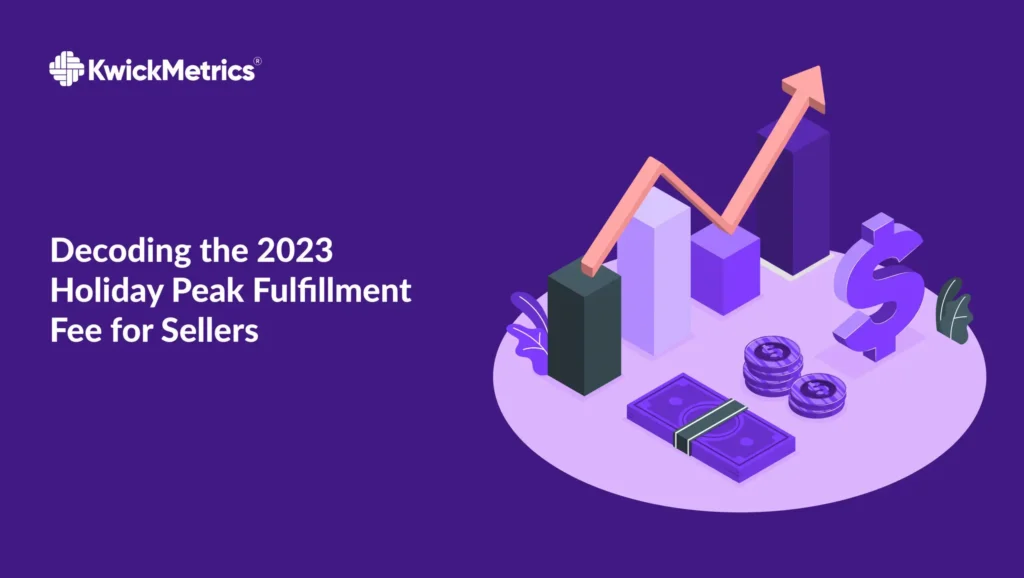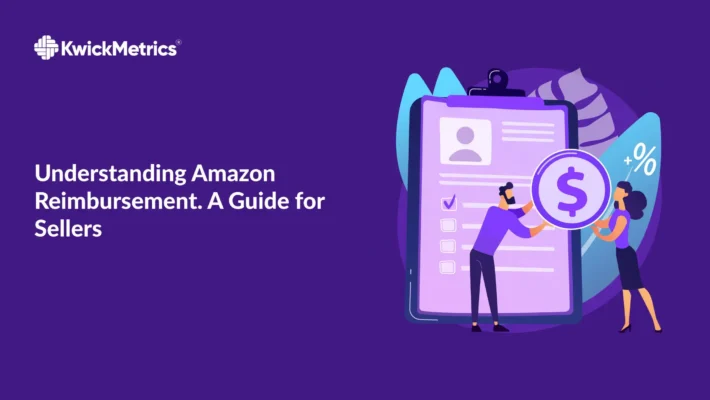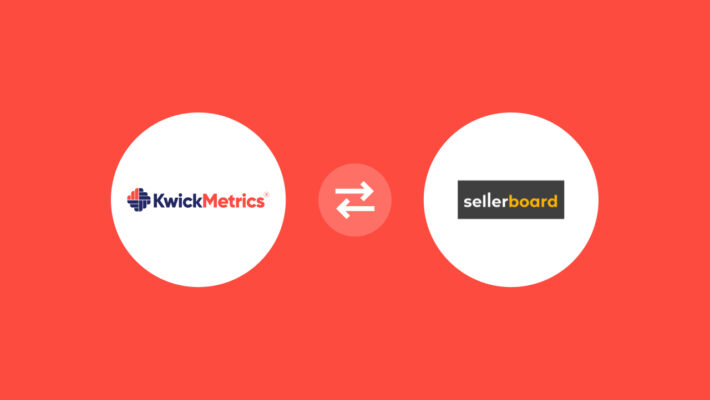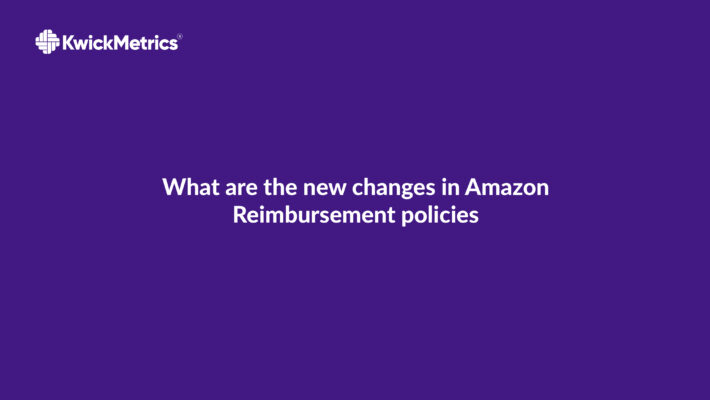Decoding the 2023 Holiday Peak Fulfillment Fee for Sellers

Table of Contents
- What is the 2023 Holiday Peak Fulfillment Fee?
- Try Our KwickMetrics - One Tool with Multiple Solutions!
- How is the 2023 Holiday Peak Fulfillment Fee Calculated for Each Marketplace?
- Difference Between the 2023 Holiday Peak Fulfillment Fee and Regular Amazon Fee for Sellers
- When is the 2023 Holiday Peak Fulfillment Fee Applicable and for Whom?
- Why was the 2023 Holiday Peak Fulfillment Fee Introduced?
- How to Calculate FBA Fulfillment Fees for the 2023 Holiday Peak Fulfillment Fee
- Strategies for Amazon Sellers to Minimize the Impact of the 2023 Holiday Peak Fulfillment Fee
- KwickMetrics - The Business Intelligence and Analytics Tool
- FAQs in Relation to 2023 Holiday Peak Fulfillment Fee
- Conclusion
Picture this: You’re an Amazon seller, and you’ve just wrapped up a successful Q3. Sales are booming, your inventory is stocked, and you’re all set to take on the holiday shopping season with gusto. Then comes October 15th…BOOM!, the 2023 holiday peak fulfillment fee hits.
“What’s that?” you might ask…
A sudden rise in FBA fees during the busiest time of year for sellers! It feels like being asked to run a marathon right after finishing a sprint – it’s exhausting and overwhelming. But wait – there’s more than what it seems!
For both seasoned sellers and novices, navigating these turbulent waters can be seen as either an extra burden or a hidden opportunity. It’s all about perspective – are you ready to unravel this challenge?
What is the 2023 Holiday Peak Fulfillment Fee?
If you’re an Amazon seller, it’s crucial to understand what the 2023 holiday peak fulfillment fee entails. The term refers to a specific fee charged by Amazon during its busiest time of year – from October 15th through January 14th.
This period, known as the “holiday peak,” sees increased online shopping activity due to major events like Black Friday and Christmas. With this surge in demand comes heightened strain on Amazon’s fulfillment centers, leading them to charge additional fees for their services.
The Rationale Behind It
The implementation of this holiday-specific cost helps cover increased operational costs that come with handling larger volumes of goods being sold and shipped out. Expect an additional charge of around 35 cents for every item sold via FBA during those days.
It’s important not just because it impacts your profit margins but also because understanding how these fees work can help better prepare your business strategy around key sales periods like Black Friday or Cyber Monday.
Navigating The Holiday Peak Fulfillment Fees Landscape
Fees related to selling on platforms like Amazon aren’t limited solely to order fulfillment; there are referral fees, storage fees – both monthly storage and long-term – plus potential inventory surcharges too. In short: sellers need a clear grasp on all financial aspects involved when planning their sales strategies.
With KwickMetrics at hand though, tracking expenses doesn’t have be complicated or stressful anymore.
Try Our KwickMetrics - One Tool with Multiple Solutions!
How is the 2023 Holiday Peak Fulfillment Fee Calculated for Each Marketplace?
If you’re an Amazon seller, it’s important to understand how the 2023 Holiday Peak Fulfillment Fee is calculated. The process varies depending on each marketplace, such as Amazon FBA USA, and factors like size and weight of items sold come into play.
Understanding Amazon’s Calculation Method
The first thing to note about this holiday fee calculation method employed by Amazon is that it isn’t static. It considers various variables in its determination, which include the physical attributes of your product, particularly its dimensions and weight.
To break it down further: let’s say you’re a UK-based seller dealing with products under the Amazon FBA UK fees category. When determining your fulfillment costs during holiday peak season, Amazon will consider not only these aspects but also any extra expenses associated with handling bulky or heavy items during high-volume periods like holidays. This includes increased labor costs and storage space requirements in amazon fulfillment centers around these busy times.
This complex system results in a fluctuating cost per item sold, making precise calculations challenging at times. But based on recent data available from sellers’ experiences, we’ve found that there’s an average increase of $0.35 per unit because of this amazon holiday peak fee.
A valuable resource that can provide more clarity on this matter are remote fulfillment programs provided by Amazon themselves, where they share information regarding all kinds of fees, including remote fulfillment fees applicable across different marketplaces globally.
Difference Between the 2023 Holiday Peak Fulfillment Fee and Regular Amazon Fee for Sellers
If you’re an Amazon seller, it’s important to understand that there are different types of fees involved in your selling process. One such cost is the Holiday Peak Fulfillment Fee. Let’s dig into how this fee differs from regular Amazon FBA Fees.
Breakdown of Regular Amazon Fees
As a part of their business model, Amazon charges sellers various fees. The most common ones include referral fees, which vary by category but typically range around 15%, and FBA fulfillment costs based on factors like size, weight and storage duration of each item sold. If we take shipping weight into account, these rates can further increase.
Aged inventory or monthly storage may also add up if products remain unsold for too long in one of Amazon’s fulfillment centers worldwide. These expenses form what we refer to as “Regular” amazon fees.
Additional Costs During The Holiday Season
The holiday shopping season brings more customer orders but with increased operational costs due to peak demand at world’s largest online marketplace – enter the ‘2023 Holiday Peak Fulfillment Fee’. This surcharge applies specifically during peak periods – from October 15th through January 14th – helping manage seasonal spikes while maintaining service levels across all marketplaces including Canada FBA.
This additional fee tends to be higher than regular processing charges; let me give you some context: For every item sold via FBA services during this period, expect an average hike of $0.35 (although actuals depend upon size & shipping weight).
These additional costs during the holiday season can add a significant burden to your overall expenses, but they’re part of doing business on Amazon. It’s essential to stay informed and plan accordingly.
Take a look at Amazon’s Big Day Deals. It’s a great example of how seasonal demand works.
Key Takeaway:
Get the hang of Amazon's 2023 Holiday Peak Fulfillment Fee. This extra charge applies during peak times, such as October 15th to January 14th. It's on top of your usual fees like referral and FBA fulfillment costs that depend on item details. Don't forget, this fee could lead to a considerable increase in your expenses.
When is the 2023 Holiday Peak Fulfillment Fee Applicable and for Whom?
The Holiday Peak Fulfillment Fee, a special charge by Amazon that’s applied during high-volume shopping seasons, isn’t something all sellers have to worry about year-round. In fact, it only comes into play from October 15th through January 14th. That’s when we hit what you might call “prime time” for online retail – the busy holiday shopping season.
If you’re an Amazon seller using FBA (Fulfillment By Amazon) services in either US or Canada marketplaces, this holiday peak fulfillment fee is particularly relevant to you. You see, during these peak times there are more customer orders coming in than usual and space at amazon fulfillment centers becomes prime real estate.
How Does This Affect Different Types of Sellers?
Different types of sellers can feel varying impacts from this additional fee depending on their inventory levels and sales volumes. Let me give you an example: if your business model involves selling large quantities of small items with quick turnover rates – like novelty socks featuring adorable kittens wearing Santa hats – then the increased fees per item sold could add up quickly over those three months.
But let’s say instead that your business specializes in handmade wooden furniture pieces—fewer overall units moved but higher value per item—you may find yourself less affected by these seasonal changes since storage fees are calculated based on size rather than quantity alone.
Tips For Navigating The Season
Savvy planning ahead of time can help minimize the impact on any type of seller though. Strategies such as optimizing your inventory before peak periods begin or exploring alternative fulfillment options outside FBA might be beneficial to consider. Remember also that tools like KwickMetrics offer valuable insights into sales analytics and expenses tracking, helping you navigate the busy holiday shopping season more effectively.
In conclusion, if you’re an Amazon seller in the US or Canada who uses FBA services during the busiest shopping period of the year – mark your calendar for October 15th to January 14th. This is when Holiday Peak Fulfillment Fees kick in, so it’s important to be prepared.
Key Takeaway:
Whether you're selling smaller items that fly off the shelves or high-value goods, this fee's impact will vary. It all depends on your inventory levels and sales volumes. Be aware, costs could pile up quickly for quick-selling items while higher-priced products might not feel the pinch as much.
Why was the 2023 Holiday Peak Fulfillment Fee Introduced?
The reason behind the introduction of Amazon’s Holiday Peak Fulfillment Fee in 2023 is tied to managing increased operational costs during peak shopping periods. The world’s largest online marketplace, Amazon, deals with a significant surge in orders and shipping demands over these busy holiday shopping seasons.
Addressing Increased Operational Costs
In response to this influx, resources need to be amped up. More workers are needed at amazon fulfillment centers, storage space needs increase due to high volumes of inventory surcharge and transportation expenses skyrocket because more goods need delivering within shorter time frames.
This fee is not just about covering those extra charges but also ensuring that sellers understand their role in maintaining efficient operations during peak times. Let’s look at it like rush hour traffic; if everyone decided they wanted to drive on the highway during prime commuting hours, there would be gridlock. Similarly, when all sellers want their products stored and shipped out by Amazon simultaneously – chaos ensues. So how does one fix this? By implementing measures such as aged inventory fees or higher fulfillment fee rates which encourage better planning among FBA Sellers.
Amazon’s news release highlighted that an average increase of $0.35 per item sold helps offset some of these increased costs for them without drastically impacting seller profits too much.
So yes. This ‘Holiday Traffic’ comes with its share of tolls (or should we say fees?). But remember – It’s all part-and-parcel (pun intended.) of running a successful business on platforms like Amazon where seasonal fluctuations play a big role.
How to Calculate FBA Fulfillment Fees for the 2023 Holiday Peak Fulfillment Fee
Navigating Amazon’s fee structure, particularly during the holiday shopping season, can be tricky. The Holiday Peak Fulfillment Fee is a seasonal surcharge that kicks in from October 15th and runs through January 14th.
Calculating Shipping Weight
The shipping weight plays an essential role in determining your holiday peak fulfillment fees. It combines both the item’s actual weight and its dimensional weight (length x width x height divided by a standard divisor). You then compare these two weights, with Amazon charging based on whichever one is greater.
A notable factor here is what Amazon refers to as ‘packaging weight,’ which they add to your product’s unit weight when calculating shipping charges. This represents the estimated average packaging materials used for all items shipped through their Fulfillment Centers.
Impact of Item Sold on holiday peak fulfillment Fees
Fees also vary depending upon whether you’re selling standard or oversized products – generally speaking, bigger or heavier items will cost more. Remember that if any aspect of your product exceeds certain thresholds (e.g., being over 20 lbs), it might get classified as “oversized,” which would affect costs.
Besides size and weight considerations, some categories have referral fees tied to them too – this means a percentage of each sale goes back into Amazon’s pockets. But don’t let these deter you; sellers can still thrive despite these extra expenses.
“Knowledge truly empowers us.” So while working out how much you’ll owe seems complex, the reality is that once you’ve got your head around these core concepts, it’s quite manageable. The main takeaway? Always stay informed about Amazon FBA fees and be prepared for the busy holiday shopping season.
Key Takeaway:
Understanding Amazon's 2023 Holiday Peak Fulfillment Fee requires knowledge of the shipping weight, which includes both actual and dimensional weights. Also, be aware that product size and category can affect fees - larger items or those in certain categories may cost more. Despite these complexities, staying informed about FBA fees will let you navigate holiday shopping season costs effectively.
Strategies for Amazon Sellers to Minimize the Impact of the 2023 Holiday Peak Fulfillment Fee
The Holiday Peak Fulfillment Fee is a reality that every seller on Amazon must face. But there are ways to soften its impact and maintain profitability during this busy holiday shopping season.
Exploring Alternative Fulfillment Options
To get around the higher FBA fulfillment fees, you might consider alternatives like Fulfilled by Merchant (FBM). In contrast with Amazon’s fulfillment centers, handling your own order processing could be more cost-effective during peak seasons when additional fees apply. Despite the potential cost savings of FBM, remember that providing quality customer service is essential to maintaining a positive reputation as an Amazon seller.
If switching entirely to FBM isn’t feasible due to volume constraints or other reasons, then perhaps using it selectively for specific items based on their size and weight could work well. This way, you avoid paying inflated rates on larger items where shipping weight significantly affects fee calculations.
Optimizing Inventory Management
A key strategy involves optimizing inventory management so as not to incur unnecessary storage fees – both monthly storage fee and aged inventory surcharge if any item stays in one of Amazon’s warehouses too long without being sold. Be proactive about moving slow-moving stock ahead of the October 15th deadline before these increased charges kick in; tools like KwickMetrics provide insightful sales analytics which help sellers plan better.
You may also consider setting up shop outside US and Canada markets where holiday peak fulfillment fee rates aren’t applied yet – although remember international selling comes with its own set of challenges including different referral fees across marketplaces.
Note: For precise calculation of FBA monthly storage costs among others associated with various options mentioned above we recommend checking out official resources provided by Amazon Seller Central.
Lastly, if your items are popular during the holiday season and you’ve got the capacity to handle returns processing in-house, then Amazon Multi-Channel Fulfillment might be a cost-effective solution as it charges lower fees than FBA.
Don’t forget:
KwickMetrics - The Business Intelligence and Analytics Tool
Explore 14-day free trial! No credit card required, cancel at any time.
FAQs in Relation to 2023 Holiday Peak Fulfillment Fee
What is the Amazon peak season charge?
The Amazon peak season charge, or holiday peak fulfillment fee, kicks in during high-demand periods like holidays to cover increased operational costs.
How much is Amazon FBA per month?
Amazon’s monthly FBA fees depend on storage volume. It ranges from $0.75 to $2.40 per cubic foot depending on time of year and item size.
How much does it cost to ship to an Amazon FBA warehouse?
Sellers pay shipping costs when sending items to an FBA warehouse. The price varies based on package weight, dimensions, and distance traveled.
What percentage does Amazon take for FBA?
Amazon’s cut for FBA services, known as a referral fee, typically hovers around 15% of sale price but can range between 6-45%, depending on product category.
How can I find out the specific fees that apply to my products during the holiday season?
Amazon provides a fee preview tool that allows you to estimate the fees that will apply to your products during the holiday season.
Can I avoid or reduce these fees, and what strategies can I use to mitigate their impact on my business?
While you may not be able to avoid these fees entirely, you can manage them by optimizing your inventory, pricing, and fulfillment methods. Staying well-prepared and planning ahead is key.
Conclusion
Now you’ve got the rundown on Amazon’s 2023 holiday peak fulfillment fee.
You understand its purpose, how it impacts sellers, and when it kicks in.
It may seem daunting at first glance but remember – every challenge is an opportunity.
You’ve learned to calculate these fees considering your product size and weight.
Now you can strategize better during the holiday season.
High-volume low-margin products might need a second look now!
You also saw how this seasonal fee affects storage costs, especially for aged inventory or dangerous goods.
That’s something to think about before stocking up for the next big shopping rush.
With careful planning and understanding of FBA fees, even busy periods like Holiday Peak Season Sales won’t catch you off guard anymore!
Let’s turn this knowledge into power and conquer those sales targets!


